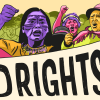Oct. 12, 2016
Rural community lands cover two-thirds of Kenya’s land area [1]. Yet, only around 6 per cent of the country’s land is formally designated for or owned by local communities, much lower than the global average of 18 per cent [2]. The new Community Land Act, signed into law on 31 August 2016, has the potential to tackle this large imbalance.
The passage of the Community Land Act marks the culmination of a long overdue effort to ensure formal legal recognition of community land rights. This was guaranteed by Kenya’s new Constitution, which came into force in 2010, and the new Land Act passed in 2012 [3]. At present, local county governments are empowered to act as trustees of communally managed land. Under this new Act, communities can apply for formal titles and once these have been issued, county governments cease to administer that land or have powers to reallocate it.
The Act makes it as easy as possible for communities to apply for formal land titles. For instance, they do not need to undergo the expensive and time-consuming process of registering as cooperatives or other legal entities. Moreover, decision-making powers related to the land are vested in a community assembly which comprises all adults. This assembly appoints a land committee to make day-to-day decisions. Since communities have been broadly defined under the Act as groups with a common interest or location, it may also be possible for non-customary groups like urban squatter communities to use the law to secure group titles to land.
Issues of community land use and ownership remain highly contentious in Kenya and recent years have witnessed an escalation in land related conflicts. In many of these cases, communal land has been transferred by the local governments for infrastructure projects or to private persons without consent or payment of compensation to the affected communities. The strong opposition to the acquisition of community land for the Lake Turkana Wind Power project, Kenya’s largest ever private investment, is a prominent example of such concerns [4]. Unfarmed pastoral or forestlands are especially at risk. Many county governments still think of these as public land, not as a part of community land. Effective implementation of the Community Land Act can go a long way towards ensuring that local communities are able to secure their legitimate rights to land, and so to resolving such conflicts.
Nevertheless, uncertainties remain.
For one, the Act came into force just a few days before a constitutionally mandated deadline for its passage, calling into question the political will required to ensure its implementation. This is particularly important because, even though the new law significantly empowers local communities, Kenya currently lacks strong community level governance institutions. The low quorums required for decision-making in the assemblies could be abused by elites, with the more marginalized sections of the community losing out. The law does not give sufficient guidance to pastoralists on how to unpack and fairly order their customary rights, which often overlap with other communities.
A major concern remains as to how far the central government will use the excuse of environmental value to claim significant amounts of customary land as public lands. The eviction of the Ogiek people in Mount Elgon exemplifies such fears [5]. As Peter Kitelo of the Kenya Forest Indigenous Peoples Network points out, “We are being evicted from our lands under the pretext that our eviction is necessary to protect the forests. These forests only remain because our way of life has protected them for centuries. This is happening despite court injunctions, despite Article 63 2 d ii and other provisions of the constitution, and despite the science which shows very clearly that securing ancestral forest community’s collective tenure over our lands, with conservation conditions, is the surest way of protecting the forests and the water that flows from them”.
A lot will depend upon the determination of communities to make the law work. According to tenure specialist Liz Alden Wily, “The implications of the Community Land Act are enormous, and not only for community land rights. Kenya failed to devolve government to community levels. Institution of active and empowered community land decision-making could help fill this gap”.
Photo: Ogiek woman speaking at a community Bylaw meeting at Chepkitale, Mt Elgon
Photo Credit: © Justin Kenrick, Forest Peoples Programme
[1] Liz Alden Wily. 2015. Estimating National Percentages of Indigenous and Community Lands: Methods and Findings for Africa. Data file from LandMark: The Global Platform of Indigenous and Community Lands. Available at: http://www.landmarkmap.org
[2] Rights and Resources Initiative. 2015. Who Owns the World’s Land? A Global Baseline of Formally Recognized Indigenous and Community Land Rights. Available at: http://rightsandresources.org/en/publication/whoownstheland/
[3] http://www.the-star.co.ke/news/2016/09/17/the-community-land-act-now-its-up-to-communities_c1420295
[4] https://www.danwatch.dk/undersogelseskapitel/storm-ahead-for-vestas-as-giant-kenyan-wind-power-project-is-in-court/
[5] https://www.theguardian.com/global-development/2016/aug/18/kenyas-ogiek-people-are-seeing-their-land-rights-brutalised


